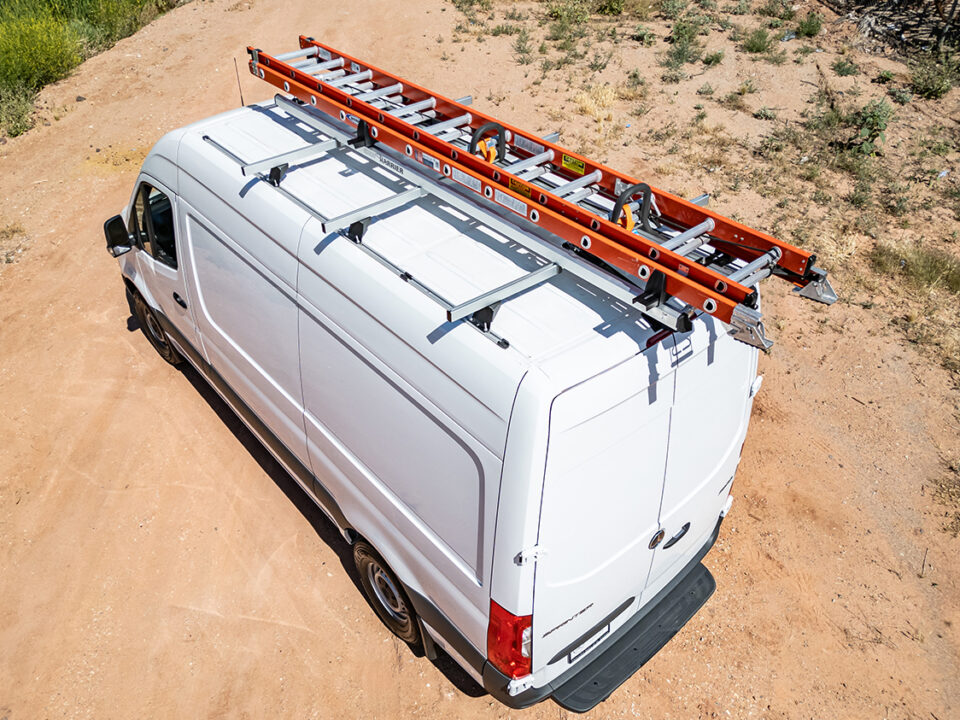
Features of Ladder Racks for Firefighting Trucks
20 November 2025Cool Ladder Racks for Commercial Vehicles
In the modern world of fleet management, utility services, construction, and emergency operations, a smart ladder rack is not just a piece of metal installed on a vehicle – it becomes a strategic component that increases efficiency, safety, and brand professionalism. Beyond just displacing heft, a truly cool ladder rack offers load-bearing strength, simple operation, compatibility with a wide range of vehicles, and flexibility to various ladder types, including step ladders, extension ladders, and even multiple ladders at once. The appropriate ladder rack is a long-term investment in worker ergonomics and risk mitigation as well as an operational asset for fleet managers, operations leads, and upfitters.
A creative ladder rack must combine clever design, high load capacity, user-friendliness, and adherence to occupational safety regulations, such as those found in the NIOSH lifting equation, in this cutthroat market where time is money and safety is non-negotiable. When properly selected, the best ladder rack completely changes the way workers operate, turning ladder deployment, storage, and transportation into a smooth, effective, and low-risk process rather than a daily source of friction.
Why is a ladder rack cool? First and foremost, it must have a strong load capacity, measured in pounds (lbs), to safely support not only one ladder but maybe two or larger extension ladders. Teams may load long extension ladders or several step ladders without overtaxing the rack or running the danger of failure thanks to wide-ranging ladder racks that can support 100, 130, or more pounds of ladder weight. When one takes into account the weight of commercial or industrial ladders, which can be significant, particularly when stacked or carried in pairs, this strength becomes quite beneficial. Second, deployment mechanisms—such as hydraulic, pneumatic, spring-assisted, or slide-and-damper systems—must provide quick, controlled ladder release and retraction without necessitating difficult maneuvering or hand lifting. A servo-assisted or hydraulic actuation system is frequently used in cool ladder racks, allowing a single operator to easily descend a ladder from the roof to the ground while lowering the danger of injury and physical strain. Third, global compatibility is a primary priority. The best ladder racks are designed to fit a variety of vehicles, including pickup trucks, high-roof service trucks, and compact vans, without requiring a lot of custom fitting.
Additionally, a really unique ladder rack will work with a wide range of ladder types, including twin ladders, step ladders, extension ladders, and even custom ladders. Lateral load stops that stop side-to-side movement during transit, secure strapping systems, and adjustable retainers all contribute to its universality. Fourth, the availability (or lack thereof) of hydraulic assistance is a crucial component. While racks with complete hydraulic systems give superior performance, more straightforward mechanical mechanisms, such as gas dampers, can offer dependable, low-maintenance operation at a cheaper cost.
The choice depends on user priorities – whether maximizing speed and ergonomic safety, or minimizing complexity and maintenance. Fifth, while making upfit judgments, adherence to NIOSH (National Institute for Occupational Safety and Health) lifting criteria is becoming more and more crucial. The Revised NIOSH Lifting Equation (RNLE) establishes a recommended weight limit (RWL) for specific lifting conditions and offers a scientifically based approach to evaluate the risk of lifting-related musculoskeletal injury. By lowering ladders to ground level, a ladder rack helps operations stay within or below NIOSH-determined safe lifting thresholds—or significantly minimizes the chance of those incidents. Sixth, durability and warranty are important. Cool ladder racks are supported by multi-year product guarantees and are constructed from premium materials like stainless steel and anodized aluminum, which provide longevity and corrosion resistance. These features reduce the overall cost of ownership while maintaining long-term performance.
Seventh, confirmed crashworthiness and safe locking are key differentiators from aerospace to fleet operators. Racks with locking catches or those that have completed crash testing (such as a 20 g impact) offer assurance that the ladder will stay secure in dynamic driving situations. Eighth, aerodynamics and sophisticated design add to the cool factor: profiles that minimize noise, minimize wind resistance, and maximize mounting footprint strengthen performance and brand identification. Nineth, product modularity and ease of maintenance complete the picture: the best ladder rack allows for modular upgrades, part replacement, and simple service, maintaining long-term dependability.
Going further, think about a stylish ladder rack such as the Gentili G2000 Harrier and G2000 Maxi. Depending on the model, these ladder racks weigh between 86 and 99 pounds and are mostly composed of anodized aluminum for strength and corrosion resistance. It can handle a wide range of ladders, including hefty extension ladders, without sacrificing safety thanks to its safe maximum carrying weight rating of 60 kg (around 132 lb). The Harrier’s deployment system employs servo-assisted dampers to enable a single user to operate without using excessive force or taking unnecessary risks. This allows the slide to descend and raise with controlled motion. Different ladder widths and lengths (step ladder, extension ladder, etc.) are safely held in place thanks to its adjustable ladder retainers that are covered in a protective material. The integrity of the car can be maintained by installing the Harrier using the original roof mounting points rather than drilling into the roof. In terms of safety, the rack has two separate locking catches that guarantee the ladder stays safely stored even when in motion. Additionally, Gentili verifies the G2000 Harrier with a TÜV GS certification and a 20 g crash test in accordance with ECE R-17 regulations, informing fleet managers and upfitters that this is not a lightweight, untested system. Operators may be confident in the manufacturing quality and lifespan of the Harrier because to its three-year warranty. Another version, the G2000 Maxi, has front and rear load brakes that may be adjusted to stop lateral movement during transit, enabling the attachment of two ladders side by side. Powered by a hydraulic mechanism, this “double ladder rack” doubles ladder capacity while maintaining the single model’s smooth, ergonomic functioning. Up to 132 pounds of total safe load (i.e., combined ladder weight) can be supported by its carrying strength. Strong, ergonomic, adaptable with many ladder types, and supported by crash certification and guarantee, these authentic Gentili models are the epitome of what makes a ladder rack “cool.” Other top ladder-rack options that meet the “cool” standards exist outside of Gentili.
Naturally, despite all of these advantages, a ladder rack’s actual worth is determined by how well it complies with safety regulations. An effective ergonomic tool for determining whether the lifting requirements of a task surpass acceptable limits is the NIOSH Revised Lifting Equation. Workers can avoid lifting large loads over NIOSHs when a ladder rack can consistently lower ladders to a comfortable height (preferably at or just above waist level). For instance, NIOSH adjusts for horizontal reach, vertical lift distance, and frequency under ideal circumstances, assuming a 51-pound load constant for two-hand lifting. A cool ladder rack helps operations stay within ergonomic safety margins by decreasing manual lifting and streamlining handling, which over time lowers the risk of musculoskeletal injuries. This commitment to ergonomic design emphasizes how crucial it is to choose a ladder rack that follows best practices rather than just capacity requirements.
Investing in a special ladder rack or the best ladder rack for your use case requires balancing capital costs, lifecycle costs, and risk from a business standpoint. Hydraulic solutions, such as Gentili’s G2000 series, may be more costly to purchase and install, but they improve deployment speed, lessen worker fatigue, and lower the danger of injury. Additionally, they improve operator satisfaction, which can boost output and lower attrition. However, non-hydraulic aided racks (manual or spring-dampers) could require less upkeep and require fewer parts to be serviced, which makes them a desirable option for fleets with limited use or budget-conscious businesses. A rack’s aerodynamic and aesthetic design is another aspect of “coolness.” Gentili’s profiles are designed to decrease noise, lessen wind resistance, and maintain the vehicle’s visual lines—a subtle but crucial aspect for service fleets that rely on brand perception. Aerodynamic racks contribute to both operational savings and environmental performance by lowering drag and increasing fuel efficiency over time.
Maintainability and modularity are equally important. Future upgrades, worn part replacement, and simple maintenance should all be supported by a stylish ladder rack. Gentili’s design ensures that the rack stays a long-term asset rather than a short-term liability by enabling the repair of retainers, rollers, and locking mechanisms without replacing the entire system. To sum up, cool ladder racks do more than just hold ladders; they also make ladder deployment, storage, and transportation safer, more intelligent, and more effective. One ladder rack is cool rather than ordinary because of features like high load capacity in pounds, ease of use via hydraulic or assisted systems, universal compatibility with vehicles and ladder types, ergonomic design aligned with NIOSH, robust warranties, crash certification, and durable materials. By providing innovative ladder rack solutions that satisfy practical operational requirements and provide long-term value, brands like Gentili are pushing the boundaries. Selecting one of these top ladder rack systems gives fleet managers and upfitters a competitive advantage in operational readiness, improved safety, less physical strain, and simpler processes.





